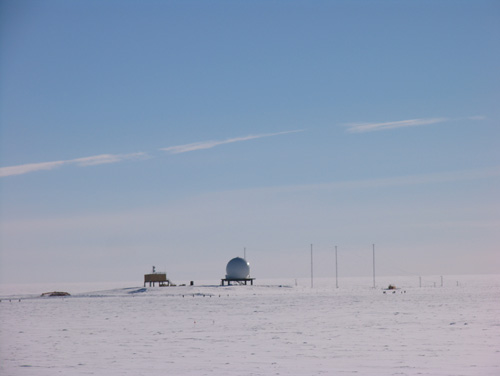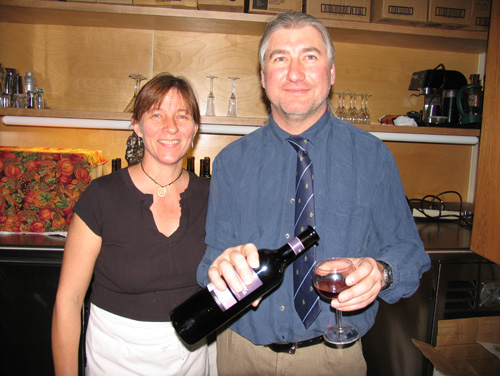Week 3 November 19 - 26 2007 Communications
Global communication is taken for granted these days. You can send email, listen to web based radio, pick up a phone to call just about anywhere, or watch CNN for the latest news everywhere. Well not quite everywhere. Most of this ability to communicate is based on either optic fiber cables criss-crossing the world, or satellites that just hover above us. At the South Pole we have no cables or fibers, and we're too far south to see those magic stationary satellites.

South Pole RF Ground Station. Marisat/GOES dish inside the "golf ball", and TDRS dishes on conroll building on the left. HF antennas on the right.
The world owes a lot to a specific type of satellite in what is know as a geosynchronous orbit. Artificial satellites, and the Moon, are continually falling towards the Earth. But their forward motion always puts them further along their path or orbit, and the curvature of the Earth means they end up at the same height as before. For a low orbiting satellite they have to move extremely fast to achieve this feat, circling the earth in hours. A very high satellite, such as the Moon, can go around the Earth at the lazy pace of once every 30 days. Here is the trick, put a satellite at exactly the height that to stay in orbit it needs to circle the earth once a day, and put that satellite in an orbit that is in the same plane as the equator, and it is going in the same direction as the rotation of the Earth. Suddenly you have a satellite that is it the same position in the sky all the time, a geostationary satellite. These are the bread and butter of global communications, you just need a satellite dish to point at it, and leave the dish alone. No tracking, the satellite doesn't set, and it is high enough that it can be seen from a large part of the Earth simultaneously.
That would all be great except that the further you move away from the equator, the lower in the sky the satellite is, until near the Pole it drops below the horizon. At South Pole we can't rely on these satellites because we can't see them. However these orbits are unstable. Left to their own devices these satellites will develop wobbles moving north and south of the equator. This needs constant attention, using little rockets on the satellite to do "station keeping" which keeps them in their place. But eventually the rockets run out of fuel, and the satellite drift away from where it should be and becomes useless to everyone, except the South Pole. Now for a short period each day as the satellite drifts south of the equator we can see it and use it for communications. Thus everyone else's junk satellites becomes South Pole's treasure.
For the last couple of years South Pole has been using 3 old satellites to get almost 12 hours of high bandwidth communications a day, TDRS F1 (24 years old), Marisat 2 (31 years old), and GOES 3 (29 years old). At present there is problem with the tracking of the ground station and there is more like 8 hours a day. These satellites allow us to make phone calls, do email, and surf the web. For the rest of the day it is possible to make emergency or important operational calls with the higher cost, low bandwidth Iridium satellite constellation, which also recently allows us to send limited small emails round the clock.
This type of satellite communication has been a recent innovation at South Pole since the mid 90s. My first phone call to Helen from Pole in 99 was a very low quality simplex link using a satellite called ATS-3, which was launched in 1967. It was the first satellite to take a colour full disk image of the Earth. When it was decommissioned a few years ago it was the oldest operational satellite. Yet in the late 90s it was considered an important operational communication link for the Pole.
The Dome era came closer to an absolute close this week with the entrance being deconstructed to do maintenance work on the fuel arches, and new storage facility. For the few people who'll understand I'll mention that the Blue Room lived up to it's history with a few incidents that left a few shaken workers wondering after near misses. For most people the pulling down of the sign was one of those rare events at Pole that can liven up 10 minutes of the day, not to be missed so you can say you where there in years to come. The Dome has been history for me since I lost my little office and had to start living in the new station. I can only hope that the US government shows more sense and preserves the iconic Dome rather than turning it into scrap in the manner of the Australian government recently when it turned it's back on one of the symbols of early ANARE, the icebreaker Thala Dan., which was recently scrapped in Brazil.

The Dome entrance with the connecting tunnels removed.
One of my main jobs this week was testing a humidifier in the science lab. Last year our data archiving system started to fail with errors no one, including the vendor, could understand. The vendor felt that there were a number of possible causes, one of which was running in a very low humidity environment. The colder air is the less capacity for holding water moisture it has. Thus the outside air at South Pole is extremely dry, and the inside air, being heated up outside air, is about the same. Water is extremely expensive to make at South Pole as ice has to be melted, and the energy used to melt the ice costs expensive fuel, though to some extent waste heat from the power plant is used. Because of the cost of water there is no chance that inside the buildings will be humidified. The tests worked and hopefully I'll get a water line run next week. But I mention the low humidity because of it's effects beyond our taping system. Lips and skin gets very dry and harsh, and for some people it causes persistent coughs. When you get off the ice and arrive in Christchurch the feeling of humidity is overwhelming. It feels fantastic. As someone put it, it is like your skin is cardboard left out in the rain soaking up water.
The normal work week at South Pole is 6 nine hour days, 54 hours. Except there is one long 2 day weekend a month. In November the long weekend is used to celebrate Thanks Giving. Of course Thanks Giving is the fourth Thursday of the month, but that would be inefficient. Not all holidays are moved for work efficiency. Christmas is usual left alone. The 2 big station celebrations of the summer are Thanks Giving and Christmas. Both are celebrated in the same way, a day off and a special meal. There was over 240 people on station this weekend, and the galley isn't up to serving this many people simultaneously. Thus the feast is server in 3 seatings. To give it some elegance the tables are set with table cloths, the usual cheap plastic plates, and light weight utensils are set out, and every one is served wine, or soft-drinks if they prefer, by waiters. For a number of years now I have been the assistant bar tender for these special occasions. This is a fun job, but is a long day starting with cleaning the bar, and shutting it down after 3 meals are served. The dinner is started outside the galley with hors d'ouvres. This gives the crew time to frantically reset the tables between seatings. Then everyone files in and is seated, to then stand up again and server themselves buffet style. There are the usual toasts by the station management. The meal is finished with a choice of traditional American pies, apple, pumpkin, or pecan. As the saying goes, a fun time was had by all. For the record, of the 6 reds and 3 whites served all but 3 were Australian.

One of the tables of hors d'ouvres on offer.

The South Pole kitchen crew, Thanks Giving 2007.

Tables set for Thanks Giving dinner.

Bar staff for Thanks Giving dinner.
I started by talking about the limitations of the satellite communications at South Pole. Without them we could not operate such advanced telescopes as IceCube, or the array of ground breaking Cosmic Microwave Background telescopes here, which require the ability to send 60GB of data to our research institutes a day (using the high bandwidth Ku Band on TDRS F1). But it wasn't long ago when the bread and butter of Antarctic communications was HF radio. Interference from solar flares could result in outages that could last days, even weeks. Bandwidth was measured by the operators Morse code speed, and compression techniques were implemented by telegraphic codes, with messages known as whizzers (WYSSA, code for "All my love daring"). This demonstrates that it is possible to live with limited contact with the outside world, as many stations did so for decades quite comfortably.
I sort of feel lucky to be at South Pole when we are still reduced to the old days of HF for at least half the day. I've had many fun experiences with the HF including the old tradition of radio darts with other Antarctic bases, Christmas Carols by HF, listening to the Melbourne cup (not that I care about horse racing, but it continues a tradition going back to my earliest memories), a couple of Rugby World Cup finals (which we lost!), and some cricket. These have all been social - sometimes small, me and an on duty radio operator who ends up learning lots about Australia - occasions in the old Comms in the Dome, which I miss a lot.

Listening to a Rugby World Cup final with the Comms crew, Rich (another Ozzie), and Nick Powel (photo thanks to). I'm wearing the Wallabies jersey.
I find the new Comms (I think it's new modern name is station operations center) a little intimidating. However, with friends working there, and something happening which I couldn't wait to hear the outcome of, after Thanks Giving dinner on Saturday I went down to Comms to listen to election coverage by Radio Australia over short wave. The reception was good enough to be intelligible, but with lots of background noise, distortion, and fading in and out. Listening to Mr. Howard concede defeat it sounded like the signal had been circling the Earth since Menzie's day. And listening to Mr Rudd claim victory it sounded like he was on another planet, not a short distance from where I lived for years when I was an undergraduate in Brisbane (who would have thought, a Queenslander as PM!).

Carrols by HF in New Comms, 2006.
By the time Mr. Rudd was finished it was getting late, and I crawled into bed at 1:30am, just in time for 3 fire alarms (luckily false alarms). Despite being very tired I was up early for our modern satellite coverage to get details of the election, and to shamefully waste bandwidth listening to the special AM election coverage (don't tell anyone, it's against policy to listen to streaming media), and then finally, since I was indulging myself already, make myself extremely home sick by listening to Macca on Australia All Over for a full hour. Long live the ABC on the web, and Radio Australia on short wave!
To be continued.

